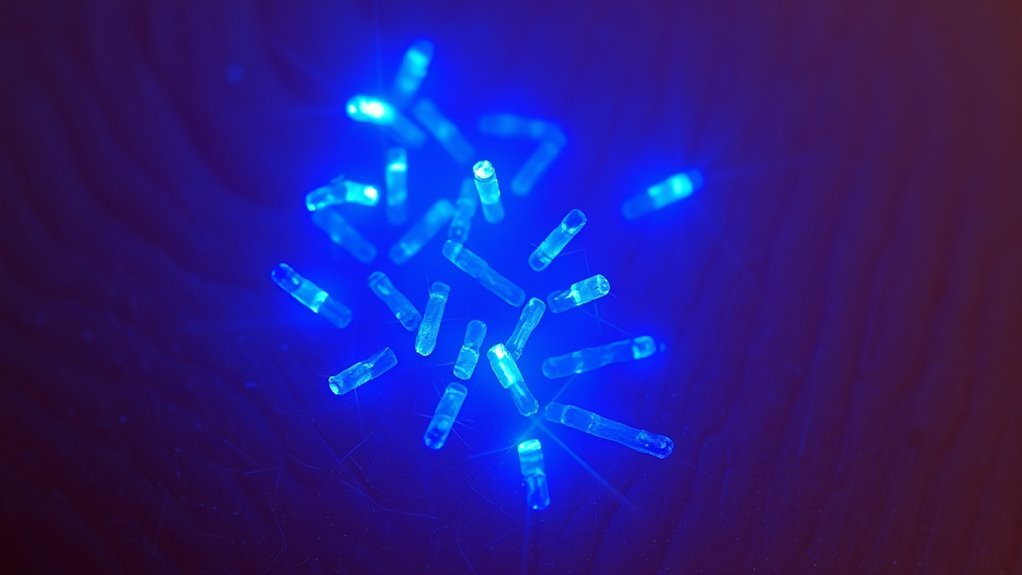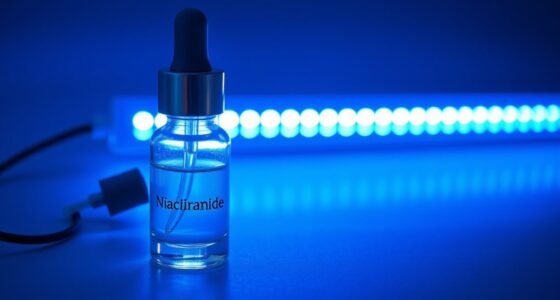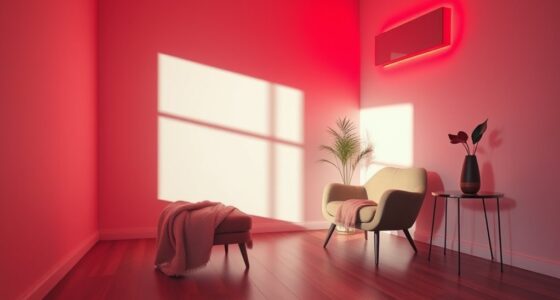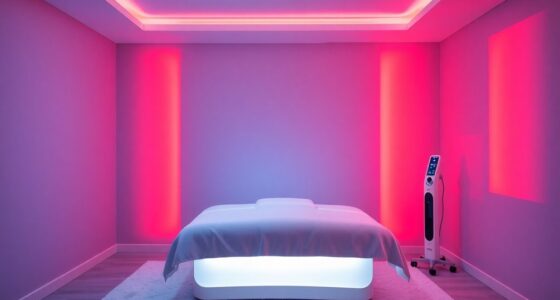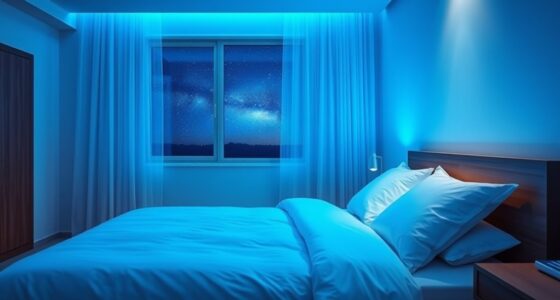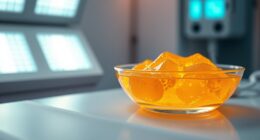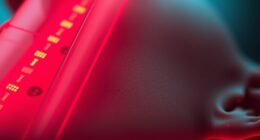Blue light targets P. acnes bacteria by activating natural molecules called porphyrins inside the bacteria. When exposed to blue light, these porphyrins produce reactive oxygen species that damage the bacterial cells, killing them. This process is selective, meaning it specifically affects the bacteria without harming your skin’s healthy cells. This safe and effective method helps reduce inflammation and clear your skin. To understand how this innovative treatment works in detail, keep exploring further.
Key Takeaways
- Blue light penetrates skin to reach bacteria inside pores, targeting P. acnes directly.
- P. acnes produce porphyrins that absorb blue light, initiating bacterial destruction.
- Blue light excites porphyrins, generating reactive oxygen species (ROS) that damage bacterial cells.
- This process is selective, damaging bacteria while sparing human skin cells, ensuring safety.
- The treatment reduces bacterial levels and inflammation, improving skin clarity naturally.
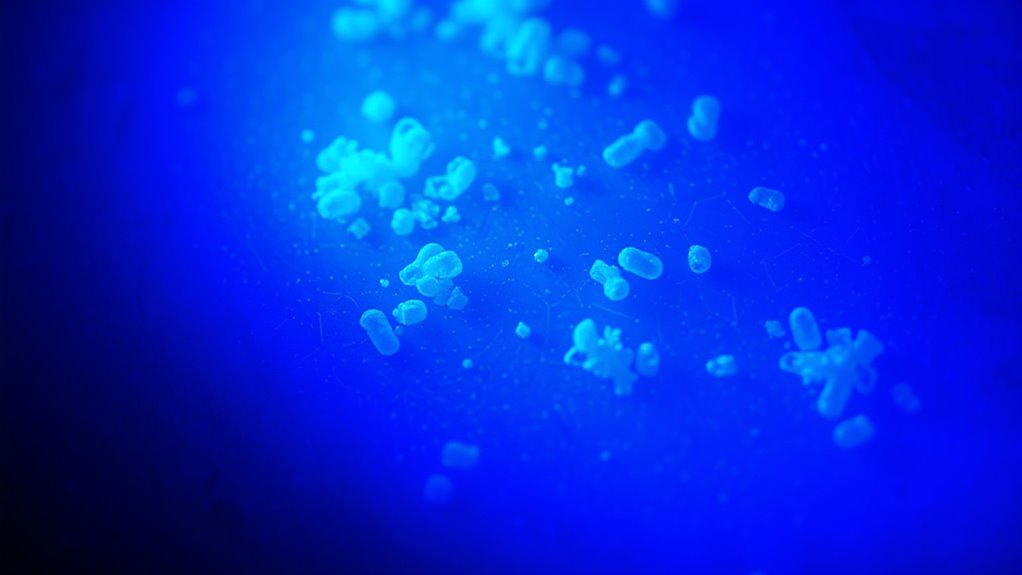
Have you ever wondered how blue light can be used to combat bacteria? It’s a fascinating area of research that’s gaining traction, especially in the fight against stubborn skin conditions like acne. Specifically, blue light targets Propionibacterium acnes, the bacteria responsible for many inflammatory skin issues. When you shine blue light on your skin, it penetrates the outer layers and interacts with the bacteria inside your pores. This interaction isn’t random; it’s based on a specific process that damages the bacteria, helping to reduce their presence and the inflammation they cause.
The key to blue light’s effectiveness lies in how it affects the bacteria’s internal components. Propionibacterium acnes contains molecules called porphyrins, which are naturally produced by the bacteria and act as photosensitizers. When exposed to blue light, these porphyrins absorb the light energy and become excited. This excitement triggers a series of chemical reactions that generate reactive oxygen species, or ROS. These ROS are highly reactive molecules that can damage bacterial cell walls, membranes, and DNA, effectively killing the bacteria or rendering them unable to reproduce.
Because blue light specifically targets these porphyrins, it’s selective in how it kills bacteria. Human skin cells don’t produce porphyrins in the same amounts or in the same way, so they’re less affected by blue light. This selectivity makes blue light a safer alternative to traditional antibiotics, which can harm healthy cells and contribute to antibiotic resistance. Plus, blue light therapy is non-invasive and painless, making it an appealing option for many people seeking a natural approach to managing acne.
The use of blue light isn’t just about killing bacteria directly; it also helps reduce the inflammation caused by the bacteria’s presence. When P. acnes die, they release inflammatory substances that can worsen redness and swelling. By decreasing the bacterial load, blue light therapy diminishes these inflammatory responses, leading to clearer skin over time. Many dermatologists now incorporate blue light treatments into their acne management plans, often combining it with other therapies for even better results.
Frequently Asked Questions
Does Blue Light Therapy Cause Any Long-Term Skin Damage?
Blue light therapy generally doesn’t cause long-term skin damage when used properly. It’s considered safe and non-invasive, with minimal risk of side effects. You might experience temporary redness or dryness, but these usually fade quickly. To stay safe, follow your dermatologist’s instructions and avoid excessive exposure. If you notice any persistent irritation or unusual changes, consult your doctor. Overall, blue light therapy is a gentle option for skin treatment.
How Often Should Blue Light Treatments Be Administered for Acne?
Think of blue light therapy as watering a garden—you don’t want to overdo it. For acne, most people get treatments 2-3 times a week, especially during the first month. After that, you might cut back to once weekly or biweekly. Consistency is key—like tending to a garden—that’s how you see clear, healthy skin. Always follow your dermatologist’s advice for best results.
Can Blue Light Be Effective Against Antibiotic-Resistant Bacteria?
Yes, blue light can be effective against antibiotic-resistant bacteria. It works by producing reactive oxygen species that damage bacterial cells, including those resistant to antibiotics. You might see improvements in your skin as the light reduces bacterial populations without contributing to resistance issues. Consistent treatments, usually a few sessions per week, are recommended to maximize results. Always consult a dermatologist to determine if blue light therapy suits your specific condition.
Are There Any Age Restrictions for Using Blue Light Therapy?
You can generally use blue light therapy at any age, but safety precautions are key. While it’s non-invasive and usually safe, children and teens should have it supervised by a healthcare professional to guarantee proper use. For older adults or those with sensitive skin, consult your doctor first. Remember, individual responses vary, so personalized guidance helps prevent any adverse effects and ensures the treatment’s effectiveness.
How Does Blue Light Selectively Target P. Acnes Without Harming Healthy Skin?
Blue light selectively targets P. acnes because it activates porphyrins produced by the bacteria, which then generate reactive oxygen species that kill the bacteria. Your healthy skin cells don’t produce these porphyrins, so they aren’t affected. This precision allows blue light therapy to reduce acne-causing bacteria effectively while minimizing harm to your surrounding healthy skin tissue. You can use it safely with minimal risk of damage.
Conclusion
So, next time you hear about blue light battling bacteria like P. acnes, remember it’s a modern marvel with roots in ancient remedies. Just like they once used sunlight to heal, today’s blue light targets bacteria without harsh chemicals. It’s a game-changer, proving that sometimes, the best solutions are right in front of us—hidden in plain sight. Who knew that in the age of dragons and knights, a simple light could be a hero for your skin?
